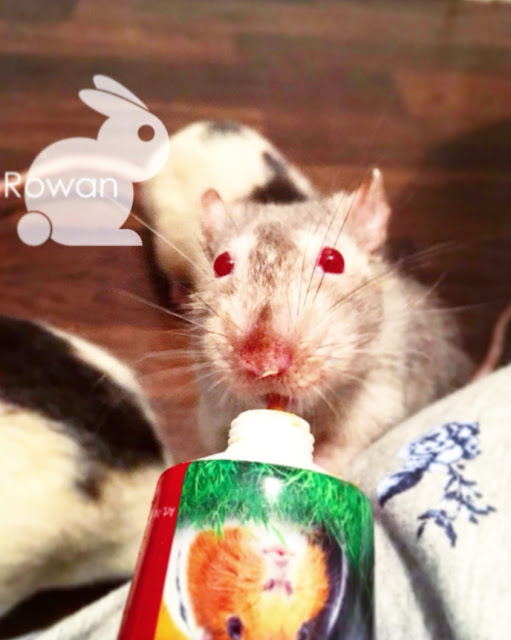Rowan - Full Write-up
Rowan was taken in due to being the last rat within his mischief, but their owner wasn't taking on any more rats. Instead of forcing him to live a life in solitude and depriving him of one of his basic needs, they decided to rehome him.
Rowan was a stunning 18-month-old Marten RED neutered buck, and had a history of inner-ear infections - they'd been resolved with antibiotics.
Rowan was a stunning 18-month-old Marten RED neutered buck, and had a history of inner-ear infections - they'd been resolved with antibiotics.
Bonding to Travis and Trevor:
As Rowan was neutered, we were fairly confident he would've been easy to bond to Travis and Trevor - two intact males.
We were right! Rowan made two beautiful friends who loved him a lot.Introducing Alfie and Arthur:
Alfie and Arthur were more difficult to bond for hormonal reasons but tolerated Rowan well as he was castrated. Eventually, we were able to bond them to the mischief too.
'Inner-ear infection' and TIA:
Rowan had developed a mild head-tilt. Given his previous medical history, the vet believed it was plausible Rowan could've developed another inner-ear infection. Rowan was introduced to oral Baytril/Enrofloxacin (fluoroquinolone antimicrobial agent) and oral Metacam/Meloxicam (NSAID) 1mg:1kg BID.
Rowan didn't respond to antibiotics or non-steroidals, so the vet wanted to admit Rowan for further investigation - we were happy to oblige.
The vet decided to check Rowan for neurological symptoms. Rowan was mildly 'stargazing' when walking and he still had a mild head-tilt. Rowan had good balance, was able to walk in a straight line, had no signs of pain, and was well within himself. The vet believed Rowan suffered a transient ischaemic attack (TIA), also known as a mini-stroke. Usually, most symptoms will eventually subside, but a TIA can be a warning sign of a stroke occurring in the future.
Rowan was sent home with no intervention, but he was to be closely monitored.
Rowan had a minor chronic head-tilt but all other symptoms subsided.
Pituitary Tumour:
Rowan was a friendly and placid rat - common with castrated rats. Suddenly, he became overly friendly and clingy towards us and seemed slightly weaker. Although less common with male rats, pituitary tumours can and do occur.
Without advanced imaging, we couldn't be certain if Rowan had developed a pituitary adenoma or a pituitary carcinoma. Although, it's worth noting that pituitary carcinomas are significantly less common. Cabergoline is an ergot derivative dopamine receptor agonist which can shrink some hormone-producing pituitary tumours (particularly those that secrete prolactin by pituitary lactotrophs), it offers more promising results when used in the early stages of the disease.
We introduced Rowan to oral Cabergoline and oral Prednisolone (corticosteroid). Using the drugs in combination can extend quality of life for several months. The vet wanted to use Prednisolone as you can easily taper the dose accordingly. The vet asked us to administer BID for three days, then QD for three days, finishing with QOD if possible - all depending on how Rowan responds to each decrease.
Without advanced imaging, we couldn't be certain if Rowan had developed a pituitary adenoma or a pituitary carcinoma. Although, it's worth noting that pituitary carcinomas are significantly less common. Cabergoline is an ergot derivative dopamine receptor agonist which can shrink some hormone-producing pituitary tumours (particularly those that secrete prolactin by pituitary lactotrophs), it offers more promising results when used in the early stages of the disease.
We introduced Rowan to oral Cabergoline and oral Prednisolone (corticosteroid). Using the drugs in combination can extend quality of life for several months. The vet wanted to use Prednisolone as you can easily taper the dose accordingly. The vet asked us to administer BID for three days, then QD for three days, finishing with QOD if possible - all depending on how Rowan responds to each decrease.
Fungal Infection:
Rowan developed an odd lesion which warranted a vet visit. The vet took some swabs for analysis.
Swabs showed white blood cells and bacteria on the surface of the skin.
The vet believed Rowan had developed ringworm. Ringworm is not a serious condition and can be easily treated, but it is highly contagious. For that reason, Rowan and his friends were quarantined. We applied topical Flamazine/Silver Sulfadiazine (antibiotic), Hibiscrub/Chlorhexidine Gluconate (antimicrobial skin cleanser), and Canesten/Clotrimazole (antifungal). Slow but visible improvements were seen.
Neurological Decline and Development of Cushing's Disease:
Rowan had an onset of neurological symptoms - likely stemming from his PT. Rowan was head pressing (a sign of headache), significant weight loss, and a loss of balance. Rowan's dose of Prednisolone was increased, and we adapted his lifestyle. We altered the cage to reduce the risk of injury and introduced weight-gain (high kcal) soft food to combat weight loss.
Unfortunately, it was palliative care from here forward.
Rowan didn't respond to an increase in Prednisolone, we swapped to subcutaneous Dexamethasone injections. There were initial improvements, but Rowan developed significant fur loss and skin lesions commonly seen with Cushing's Disease/Hyperadrenocorticism.
The pituitary gland, formerly known as the master gland, is a small endocrine gland that stimulates and controls hormone-production of other endocrine glands. These hormones control how some organs work.
Cushing's Disease usually occurs due to a functional tumour of the pituitary gland. The tumour produces high levels of an adrenocorticotropic hormone (ACTH) which, in turn, causes the adrenal glands (important endocrine glands) to produce high levels of cortisol. Cabergoline would be unable to influence this type of pituitary tumour.
Although Pituitary adenomas (whether functional or non-functional microadenomas or macroadenomas) do not spread outside the skull, they can still invade nearby tissues and structures.
We suspect Rowan had a functional corticotroph microadenoma.
As Rowan was experiencing signs of uncontrollable severe pain, likely due to compression of the brain, we decided the kindest thing for Rowan was humane euthanasia.
Rowan passed away on the 11th of November 2019.



















Comments
Post a Comment